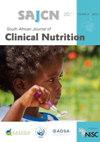Nutritional status and psychomotor development in 12–18-month-old children in a post-intervention study
IF 0.6
Q4 NUTRITION & DIETETICS
引用次数: 0
Abstract
Objectives: A study was undertaken to determine whether benefits gained by providing small-quantity lipid-based nutrient supplements (SQ-LNS) from age 6–12 months were maintained at age 18 months compared with a delayed intervention. Design: Children who completed a randomised controlled trial were enrolled at age 12 months (n = 392) and followed-up until age 18 months (n = 252; dropout rate 35.7%). Two previously exposed (PE and PE-plus) groups (received SQ-LNS from 6–12 months, but no supplement from 12–18 months) were compared with the delayed intervention (DI) group (received no supplement from 6–12 months, but received SQ-LNS from 12–18 months). Methods and outcome measures: At age 12 and 18 months, weight, length, haemoglobin (Hb) and psychomotor development were measured. Setting: The study was carried out in peri-urban Jouberton area, Klerksdorp, South Africa. Subjects: Children aged 12–18 months. Results: Compared with DI, negative effects (either a trend or statistically significant) were observed for PE and PE-plus for length-for-age Z-scores (LAZ) (p = 0.091 and p = 0.075, respectively), PE-plus for weight-for-age Z-scores (WAZ) (p = 0.027), and PE and PE-plus for Hb (p = 0.080 and p = 0.033, respectively); and a positive effect for PE-plus for eye–hand coordination (p = 0.086). The odds for anaemia were higher for PE-plus compared with DI (OR = 1.68; 95% CI 0.91, 3.09). Regardless of group, prevalence of anaemia and stunting increased from age 12 to age 18 months. Conclusions Benefits of providing SQ-LNS from age 6–12 months were not sustained at age 18 months, compared with providing SQ-LNS from age 12–18 months. Studies to determine the optimum supplementary period to achieve sustainable benefits of SQ-LNS on linear growth and iron status are warranted.干预后研究中12 - 18个月大儿童的营养状况和精神运动发展
目的:进行了一项研究,以确定与延迟干预相比,从6-12月龄提供少量脂质营养补充剂(SQ-LNS)所获得的益处是否在18月龄时保持。设计:完成随机对照试验的儿童在12个月大时入组(n = 392),随访至18个月大(n = 252;辍学率为35.7%)。两个先前暴露(PE和PE +)组(6-12个月接受SQ-LNS,但12-18个月没有补充)与延迟干预(DI)组(6-12个月没有补充,但12-18个月接受SQ-LNS)进行比较。方法和结果测量:在12个月和18个月时,测量体重、身高、血红蛋白(Hb)和精神运动发展。环境:本研究在南非Klerksdorp的Jouberton城郊地区进行。研究对象:12-18个月的儿童。结果:与DI相比,PE和PE-plus的年龄长度z -评分(LAZ) (p = 0.091和p = 0.075), PE-plus的年龄体重z -评分(WAZ) (p = 0.027), PE和PE-plus的Hb (p = 0.080和p = 0.033)均出现负面影响(有趋势或有统计学意义);pe +对手眼协调能力有正向影响(p = 0.086)。pe +组贫血的几率高于DI组(OR = 1.68;95% ci 0.91, 3.09)。不论年龄组,从12个月到18个月,贫血和发育迟缓的患病率都有所增加。与12-18月龄提供SQ-LNS相比,6-12月龄提供SQ-LNS的益处在18月龄时无法持续。有必要研究确定最佳补充期,以实现SQ-LNS对线性生长和铁状态的可持续效益。
本文章由计算机程序翻译,如有差异,请以英文原文为准。
求助全文
约1分钟内获得全文
求助全文
来源期刊

South African Journal of Clinical Nutrition
NUTRITION & DIETETICS-
CiteScore
2.50
自引率
9.10%
发文量
21
期刊介绍:
1.The Journal accepts articles from all basic and applied areas of dietetics and human nutrition, including clinical nutrition, community nutrition, food science, food policy, food service management, nutrition policy and public health nutrition. 2.The Journal has a broad interpretation of the field of nutrition and recognizes that there are many factors that determine nutritional status and that need to be the subject of scientific investigation and reported in the Journal. 3.The Journal seeks to serve a broad readership and to provide information that will be useful to the scientific community, the academic community, government and non-government stakeholders in the nutrition field, policy makers and industry.
 求助内容:
求助内容: 应助结果提醒方式:
应助结果提醒方式:


